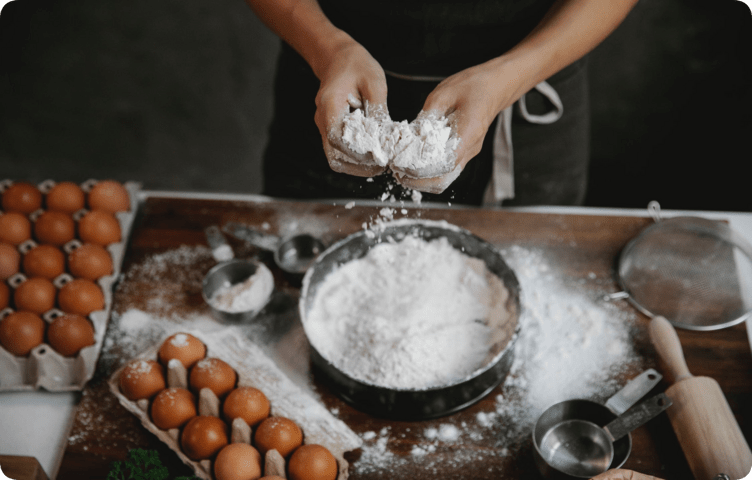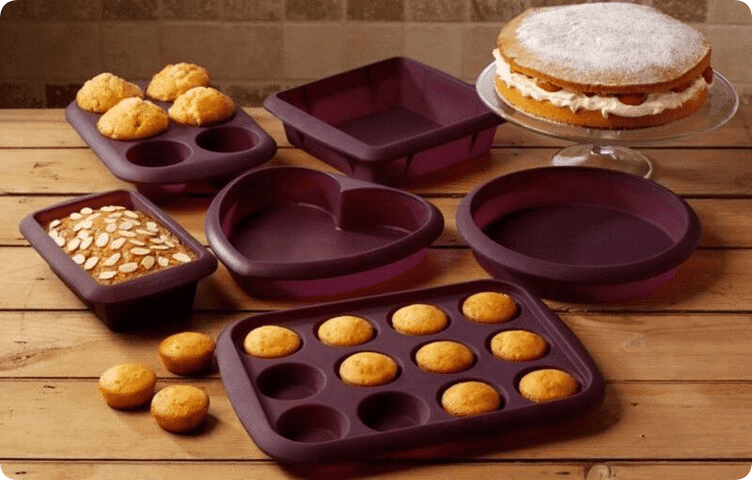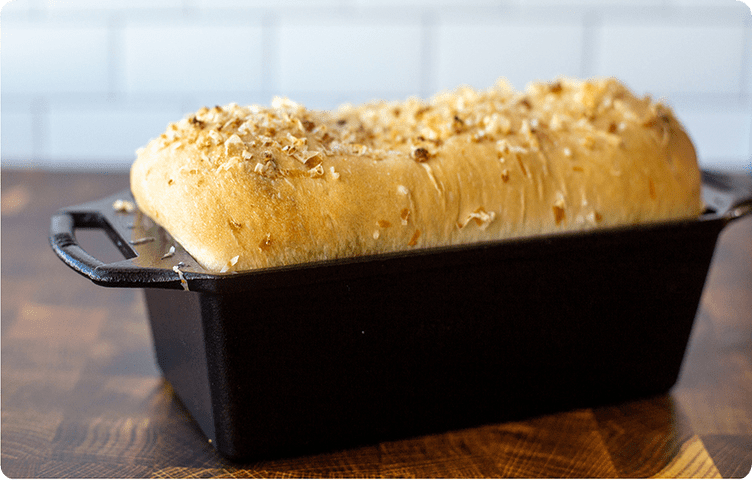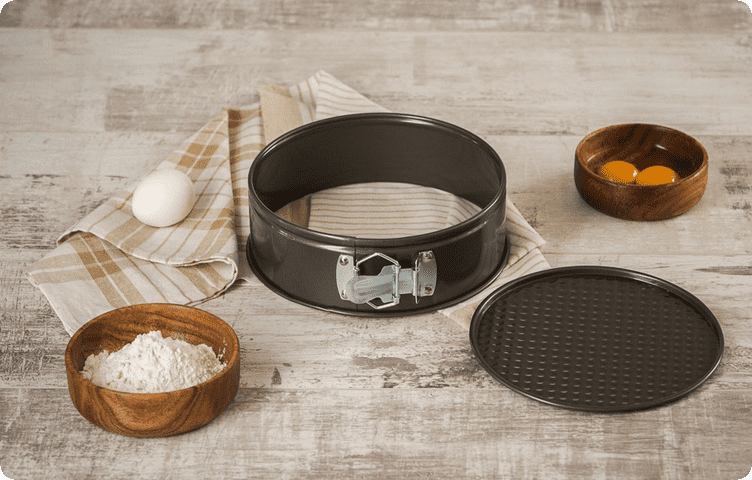Delicious pies, cakes and muffins are made if you have a proven recipe and suitable ovenware. The taste of baked goods is influenced by the volume and design of the mold, the material from which it is made. But how can a novice cook understand these nuances? Our detailed review of confectionery equipment will help!
Types and characteristics of baking dishes
Modern cooking knows more than a thousand varieties of baked goods - from mini crackers to luxurious wedding cakes. Each type of delicacy requires not only a set of specific products, but also heat-resistant cookware of the appropriate size and shape.
Diameter
The size of baking utensils is directly related to the type of future product. For large pies , round containers with a diameter of 20-22 cm are used. Confectioners consider this size to be optimal, as it helps to quickly bake cake layers, muffins, and sweet pies.
Rectangular dishes measuring 22x33 cm with high sides are also popular. This size is suitable for making manna cakes, brownies, and pies with savory filling.
In stores you can find options with larger diameters - 24, 26, 28 cm. Confectioners prepare cake layers, sweet pies, quiches, and casseroles in them. Small-sized products are intended for baking muffins, cookies, and pastries. The diameter of such molds varies from 5 to 11 cm.
Volume
Capacity is important when calculating ingredients. Whole pies, Easter cakes, and muffins require deep containers; cake layers are baked in wide containers with low sides.
There are three types of forms:
- small – hold from 250 ml to 1.5 l;
- medium - designed for 1.5 - 3 liters;
- large - over 3 liters.
Small size products are sold in sets of 2-8 pieces. To make layer cakes, it is recommended to buy 2 medium or large containers to bake several cake layers at the same time.
Purpose
Round dishes are most popular among confectioners, as they are suitable for preparing various desserts - cheesecakes, brownies, puff pastries. Round shapes are often equipped with convenient details, including:
- split bottom or sides - used for baking cakes;
- hole in the center - intended for cupcakes;
- bottom with a convex pattern - allows you to decorate the top of the pie;
- wavy edges are an integral feature of muffins and curd puddings;

Square and rectangular utensils are interchangeable. The main purpose of such products is cakes and rolls. Pies with savory filling are usually made rectangular.
Another useful option for pastry equipment is a baking sheet with high sides. It is suitable for preparing both desserts and hot dishes. It is convenient to bake small baked goods on a baking sheet - cookies, bagels, pies.
Manufacturers of kitchen utensils also offer shaped sets for certain types of small baked goods. Containers with ribbed edges are intended for cupcakes, and shell molds are for madeleine cookies. Christmas gingerbread cookies are traditionally baked in the shape of stars and hearts.
Beginner cooks are advised to choose universal utensils - round or rectangular, with smooth high sides. Equipment suitable for different types of baking will help you gradually master simple recipes.
Forms by materials
Baking utensils are made from metals, heat-resistant glass, ceramics and silicone. The ability of a material to transfer heat directly affects the speed and efficiency of baking.
Silicone forms
Food grade silicone is a heat-resistant rubber based on silicon compounds. Containers made from it are elastic and light in weight, can withstand temperature changes, and do not enter into chemical reactions with products.

Silicone does not burn in the oven , even if you do not grease it with oil. The dough bakes evenly and quickly. The material can be used in a microwave oven.
Manufacturers produce both laconic and shaped molds in the form of stars, flowers, and shells. Such products are inexpensive, so you can gradually collect a whole collection of equipment for different types of baked goods. Silicone is easy to removeWashable with regular detergents and dishwasher compatible. Elastic containers do not require much care during storage - just stack them on top of each other and put them in a cupboard.
The disadvantages of the material include excessive flexibility, which makes silicone dishes with dough difficult to move. If you are careless, the thin walls can be pierced with a knife. Silicone melts in an open flame; it cannot be used in the oven at temperatures above +300° C.
Aluminum
Baking utensils must be resistant to corrosion, high temperatures, and cleaning agents. Aluminum products meet all these requirements. Light metal does not rust and does not react with household chemicals. Aluminum is an elastic material, so products of various configurations are made from it, including containers with wavy and ribbed sides.
Another advantage of aluminum is excellent thermal conductivity , thanks to which the dough bakes quickly and evenly. Baking containers heat up quickly and retain heat for a long time.

A big plus, especially for catering establishments, is the low weight of aluminum equipment. It is much more convenient to move it around the kitchen than steel and cast iron equipment. Smoothness and shine give aluminum its aesthetic appeal. Baked treats look beautiful in sleek and shiny aluminum cookware.
The main disadvantage of the material is insufficient rigidity. If handled carelessly, it bends, and due to sudden changes in temperature, it becomes deformed. Contact with acidic foods will cause stains on aluminum utensils.
Glass forms
Heat-resistant glassware is suitable for most types of baking. It does not react with acidic foods and does not emit toxic substances.
Glass has good thermal conductivity , so it evenly heats confectionery products, preserving the juiciness and aromas of the products. Glass oven containers are easy to clean with non-abrasive detergents. Tempered glass and glass ceramics are dishwasher compatible. If there is not enough fat, the dough may burn, but soaking helps remove the soot. With proper care, glass ovenware will last at least 10 years.
The main disadvantage of the material is insufficient strength. With a strong impact, even thick-walled dishes break or become chipped. Heat-resistant containers can withstand temperatures up to + 300° C. Exceeding the thermal regime leads to cracks.
Metal molds

Stainless steel is suitable for making baked goods that require strong and prolonged heating - pies made from yeast and puff pastry, Easter cakes, homemade bread. The metal concentrates heat well, resulting in the formation of an appetizing crispy crust on culinary products.
Stainless steel does not come into contact with acids, so you can cook pies with berry and fruit fillings in metal dishes . Steel utensils are indispensable when you need to quickly prepare sponge cakes, muffins, and shortbread cookies. Effective heating gives the dough a fluffy, loose texture and a beautiful golden brown color.
Caring for stainless steel is simple - it can be easily washed by hand using ordinary washing liquids. Dishwasher safe.
A significant disadvantage of steel utensils is the risk of food burning. Even with a non-stick coating, the cakes are difficult to remove. The heavy weight of metal products makes them difficult to move.
Cast iron molds

Cast iron oven utensils surpass all other materials in thermal conductivity. Heating slowly, the heavy material retains heat inside for a long time. Confectioners use this property when baking products from thick dough - cake layers, pizza, puddings, meat rolls.
Cast iron containers are durable, stable, and easy to clean. Over time, a natural non-stick layer forms on the surface.
The main disadvantage of cast iron is its heavy weight, which makes it difficult to move dishes in and out of the oven. The material is inferior in strength to stainless steel. If you pour cold water over a hot cast iron pan, it may crack.
Ceramic forms
Cooking in containersmade of ceramics emphasizes the natural taste of products. Meat and fruit fillings become juicy, and the aromas of spices intensify. This is due to the fact that ceramic utensils evenly distribute heat within the contents.
Ceramics has five more important advantages:
- strength;
- heat resistance;
- health safety;
- smooth surface that does not absorb bacteria and foreign odors;
- ease of care.

For all their advantages, ceramic containers are not always convenient in an ordinary kitchen. They are fragile and require careful handling and separate storage. Ceramics cannot be washed in the dishwasher.
Teflon
Metal utensils with a non-stick layer are suitable for baking large culinary products - shortbread and layer pies, cake layers, quiches. The dish is easy to remove; the pan does not need to be greased or covered with parchment paper. It heats up quickly in the oven and evenly cooks the dough and any fillings, including meat and poultry.

But the Teflon coating is easily damaged by metal objects. When cooking, you can only use wooden or silicone spatulas. Washing in the dishwasher is excluded, as is use in the microwave.
How to choose a baking dish
The main factor you need to rely on is your culinary experience. If you already know how to bake, choose utensils that you will use for your favorite recipes. For beginners, a universal round product with a diameter of 18-22 cm is more suitable.
Here are four more selection criteria:
- material – aluminum is considered the best option. It is easy to work with and compatible with all types of dough. But if you already have an aluminum mold in your kitchen arsenal, choose ceramics or cast iron;<\li>
- size - make sure the product will fit in your oven. Measure the inside of the oven in advance and look for a vessel that meets these parameters;
- wall thickness - containers that are too thin will quickly deform. During the baking process, they heat unevenly, causing the dough to burn;
- color - the inside should be light. The dark surface absorbs heat faster, so the middle of the pies will not be baked enough. The only exception to this rule is Teflon-coated utensils.
If you are going to experiment with different types of baked goods, buy a set of containers of different diameters and volumes.
How to use baking dishes
To get a beautiful, even cake, the dishes need to be properly prepared. Whatever the material of the container, grease the inside with a thin layer of softened butter. If you don't have a non-stick coating, line the bottom with a sheet of parchment paper.
Remove the product immediately after removing it from the oven. Once the mold has cooled, wash it with warm water. If the cake is burnt, soak the container in warm water and some washing up liquid. After washing, dry the dishes with a soft cloth. It is recommended to lubricate cast iron products with vegetable oil from time to time to avoid rust.
















































/https%3A%2F%2Fcomplexbar.com%2Fimages%2Fblog%2F58%2Fformy-dlya-vypechki.jpg)
/https%3A%2F%2Fcomplexbar.com%2Fimages%2Fblog%2F245%2Fskov_glavn.jpeg)
/https%3A%2F%2Fcomplexbar.com%2Fimages%2Fblog%2F245%2Fhaiboli.jpg)
/https%3A%2F%2Fcomplexbar.com%2Fimages%2Fblog%2F245%2Fvilki-na-stole-752x480.jpeg)
/https%3A%2F%2Fcomplexbar.com%2Fimages%2Fblog%2F246%2F2024-04-09_17.22.54.jpg)
/https%3A%2F%2Fcomplexbar.com%2Fimages%2Fblog%2F246%2F2024-04-09_17.22.47.jpg)
/https%3A%2F%2Fcomplexbar.com%2Fimages%2Fblog%2F246%2FCODE_anons_foamydrops_752%D1%85480_eng.jpg)
/https%3A%2F%2Fcomplexbar.com%2Fimages%2Fblog%2F246%2FAlina_752%D1%85480_eng.jpg)
/https%3A%2F%2Fcomplexbar.com%2Fimages%2Fblog%2F246%2F2024-04-09_17.23.22.jpg)
/https%3A%2F%2Fcomplexbar.com%2Fimages%2Fblog%2F246%2F2024-04-09_17.23.28.jpg)
/https%3A%2F%2Fcomplexbar.com%2Fimages%2Fblog%2F246%2F2024-04-09_17.23.35.jpg)
/https%3A%2F%2Fcomplexbar.com%2Fimages%2Fblog%2F246%2Fdrinksome_752%D1%85480_eng.jpg)
/https%3A%2F%2Fcomplexbar.com%2Fimages%2Fblog%2F246%2Fnude_752%D1%85480_eng.jpg)
/https%3A%2F%2Fcomplexbar.com%2Fimages%2Fblog%2F246%2F752%D1%85480_eng__1_.jpg)
/https%3A%2F%2Fcomplexbar.com%2Fimages%2Fblog%2F246%2F752%D1%85480_eng.jpg)
/https%3A%2F%2Fcomplexbar.com%2Fimages%2Fblog%2F246%2FStudioRaw_752%D1%85480_eng.jpg)
/https%3A%2F%2Fcomplexbar.com%2Fimages%2Fblog%2F246%2FDoppio_tea_752%D1%85480_eng.jpg)
/https%3A%2F%2Fcomplexbar.com%2Fimages%2Fblog%2F246%2FTognana_Stars_Stripes_752%D1%85480_eng.jpg)
/https%3A%2F%2Fcomplexbar.com%2Fimages%2Fblog%2F246%2FRona_752%D1%85480_eng.jpg)
/https%3A%2F%2Fcomplexbar.com%2Fimages%2Fblog%2F246%2FDoppio_vending_752%D1%85480_eng.jpg)
/https%3A%2F%2Fcomplexbar.com%2Fimages%2Fblog%2F246%2FEssence_sukhie_smesi_752%D1%85480_eng.jpg)
/https%3A%2F%2Fcomplexbar.com%2Fimages%2Fblog%2F246%2FODK_sukhie_smesi752%D1%85480_eng.jpg)
/https%3A%2F%2Fcomplexbar.com%2Fimages%2Fblog%2F246%2Funiforma-barmena.jpg)
/https%3A%2F%2Fcomplexbar.com%2Fimages%2Fblog%2F246%2Fkak-nanyat-barmena.jpg)
/https%3A%2F%2Fcomplexbar.com%2Fimages%2Fblog%2F246%2Fsirop_scale_2400.jpeg)
/https%3A%2F%2Fcomplexbar.com%2Fimages%2Fblog%2F246%2FPeugeot_Anons_Paris_U%27Select_Line_Daman_752%D1%85480_eng.jpg)
/https%3A%2F%2Fcomplexbar.com%2Fimages%2Fblog%2F246%2Fkofe-vostochniy.jpg)
/https%3A%2F%2Fcomplexbar.com%2Fimages%2Fblog%2F246%2FMadler.jpg)
/https%3A%2F%2Fcomplexbar.com%2Fimages%2Fblog%2F246%2Fprofbartender_glavn.jpeg)